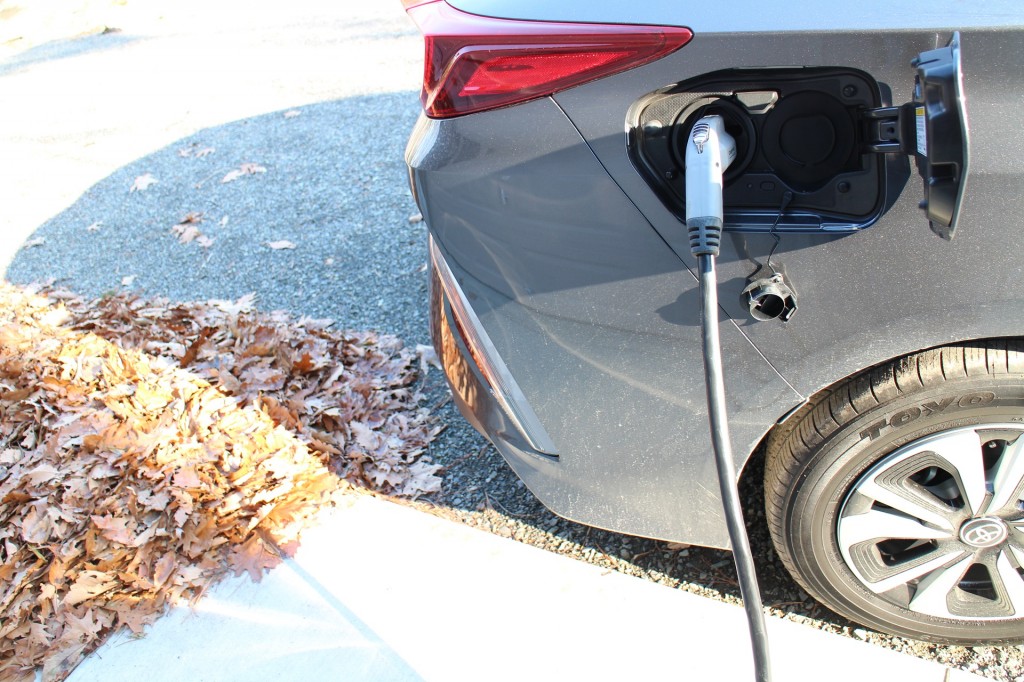
2017 Toyota Prius Prime, Catskill Mountains, NY, Nov 2016
Sales of plug-in electric cars are rising steadily in North America, Europe, and Asia, with roughly 2 million now on the world's roads.
China is debating when it will ban sales of new vehicles with combustion engines.
Meanwhile, Toyota—one of the four largest global automakers—is only reluctantly planning to launch its own battery-electric car for 2020, the first it will have designed for mass production.
DON'T MISS: Toyota, Panasonic agree to study prismatic battery cells for electric cars
On Monday, Toyota's Japanese headquarters released a plan for the "popularization of electrified vehicles for the decade 2020-2030."
The statement commits Toyota to a goal of selling more than 5.5 million electrified vehicles a year by 2030. It currently sells about 10 million vehicles a year worldwide.
Most of those vehicles will likely still use the hybrid-electric technology that Toyota pioneered in 1997 and that has become its green calling card with more than 10 million sales over 20 years.

Toyota President Akio Toyoda (left) and Panasonic President Kazuhiro Tsuga
By 2025, Toyota said, every model in the lineup will have an "electrified" option, meaning it will no longer develop vehicles that have solely engine-only powertrains.
Within those 5.5 million electrified vehicles a year by 2030, the company says there will be 1 million zero-emission vehicles.
Those will be, the company says, both battery-electric and hydrogen fuel-cell vehicles.
READ THIS: Hey, media, get it straight: "electrified" is NOT "electric," and the difference matters
Toyota also committed to offering "more than 10 battery-electric vehicles" worldwide in the "early 2020s," starting in China.
Electric cars launched in China will be followed by a "gradual introduction" of all-electric vehicles to other markets, including Japan, India, the United States, and Europe.
In other words, it's likely to be at least five years before you can drive out of your local U.S. Toyota dealer in a battery-electric vehicle.

2012 Toyota RAV4 EV, Newport Beach, California, July 2012
The planned lineup of vehicles powered by fuel cells, meanwhile, will expand to encompass both passenger cars (e.g. the current Toyota Mirai) and commercial vehicles, perhaps like the "Project Portal" hydrogen fuel-cell semi tractor now being tested in Los Angeles.
As they expand to cover every vehicle Toyota makes, hybrids will grow to include both more powerful versions—that Toyota Tundra hybrid pickup truck, anyone?—and a simpler hybrid system for markets that will accept it.
But plug-in hybrids get short shrift in the plan. Toyota says only that it "aims to expand its plug-in hybrid lineup in the 2020s."
CHECK OUT: Toyota to sell electric cars in China, use Suzuki EVs in India, from 2020: report
Today the company offers just a single plug-in hybrid model, the Toyota Prius Prime derived from its fourth-generation Prius Liftback conventional hybrid hatchback.
Any announcement of future technology directions from a company as large as Toyota needs to be taken seriously.
But what should we take away from this morning's announcement?

2017 Toyota Prius Prime, Catskill Mountains, NY, Nov 2016
We see the statement as a codification of several topics that have swirled around Toyota's future direction for a few years now.
It's clear from discussions within the industry that Toyota has long planned to exploit its commitment to the hybrid-electric vehicles it pioneered and the hydrogen fuel-cell vehicles it believes are the best technology for long-range zero-emission vehicles.
However, lately the company seems torn.
Clearly electric vehicles are popular with many of the same buyers who used to snap up the Toyota Prius. But in the face of continued low gasoline prices and rising fuel economy in all vehicles, the Prius simply hasn't maintained the sales Toyota was used to.
READ MORE: Why Toyota's 'agonizing' U-turn toward electric cars? Because China says so
Now China is essentially mandating every automaker to sell notable volumes of plug-in cars—starting at 4 to 6 percent of sales in 2020—as a condition of staying in the world's largest vehicle market.
Our conclusions:
(1) Toyota's momentum is clearly with its gasoline-electric hybrid system, and that will be the core of its efficiency efforts well into the 2020s.
(2) The company isn't any more enthused about vehicles with plugs than it has been to date, but it is being forced to build them for China—which it will do, reluctantly. Other markets may get electric cars too, eventually.
(3) This statement has little new, but the focus on "electrified" may be misread as more of a commitment to plug-in electric vehicles than it is.
We reached out to Toyota in the U.S. for their comments on today's announcement from Japan, but had not heard back at the time this article was published.
_______________________________________













